 It's been a year and a half of drama and gossip since Galliano's ungraceful exit from Dior.
Raf Simons only had a few months from his own departure from Jil Sander to prepare for his Dior debut.
It's been a year and a half of drama and gossip since Galliano's ungraceful exit from Dior.
Raf Simons only had a few months from his own departure from Jil Sander to prepare for his Dior debut.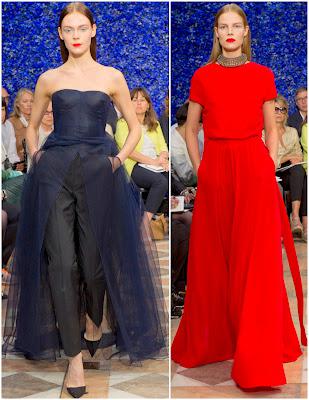
I've read a lot of negative reviews since the show this morning. I'm not sure if people expected Raf Simons into Galliano in four months but it seemed obvious to me that it wasn't going to work out that way. Simons has always been a minimalist and, when looking through the archives, Dior himself was a bit of a minimalist. Galliano's take was often beautiful and theatrical but it was his personal spin. To associate Dior with ONLY John's work is to ignore the house's storied and innovative history.
Sorry. I'm done ranting. On to Raf's debut collection for Dior!
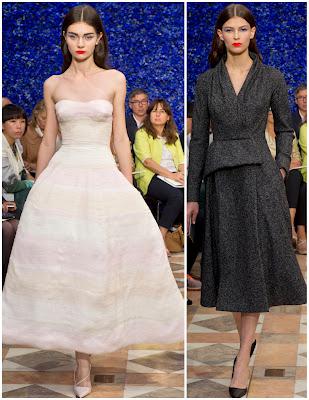 Raf's Dior is a quiet, modern take on "The New Look", created by Christian Dior in his Spring/Summer 1947 collection. It was certainly a minimalist collection although there were moments of glamour with heavily embellished gowns. But I was quite taken with the overall simplicity of the collection. I loved the classic New Look silhouettes updated with geometric prints, metal belts, and delicate, embellished tops paired with sleek black pants. He was able to capture the femininity of the past AND the restraint of modern dressing beautifully without compromising either idea.
I loved the cocoon feel of his elegant, gray tweed coats that embraced (rather than distorted) a woman's shape. While there was a lot of black, there was also an amazing amount of bright color for a Fall/Winter collection, and all of it worked together to create a cohesive collection.
Raf's Dior is a quiet, modern take on "The New Look", created by Christian Dior in his Spring/Summer 1947 collection. It was certainly a minimalist collection although there were moments of glamour with heavily embellished gowns. But I was quite taken with the overall simplicity of the collection. I loved the classic New Look silhouettes updated with geometric prints, metal belts, and delicate, embellished tops paired with sleek black pants. He was able to capture the femininity of the past AND the restraint of modern dressing beautifully without compromising either idea.
I loved the cocoon feel of his elegant, gray tweed coats that embraced (rather than distorted) a woman's shape. While there was a lot of black, there was also an amazing amount of bright color for a Fall/Winter collection, and all of it worked together to create a cohesive collection.
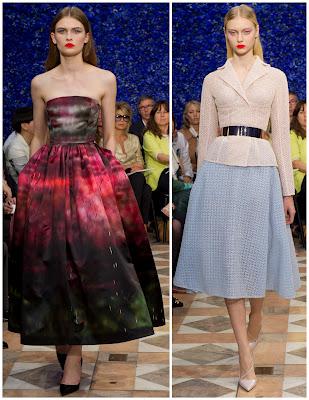
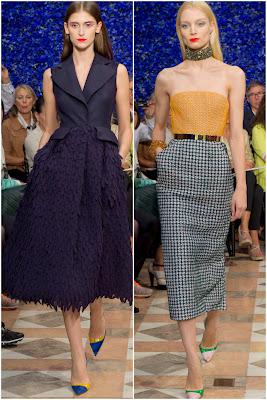
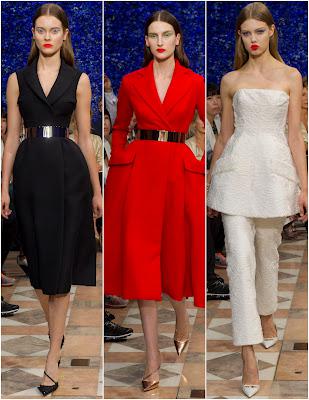
My only complaints are probably nit-picky, especially as I'll probably never own Dior couture myself, but the visible bra cups just look tacky to me. There also seemed to be a lot of fit issues around models chests throughout the collection but especially when the gowns included the visible cups in the design. They seemed too small and oddly shaped to fit an actual breast and they moved and shifted unflatteringly as the models breezed down the runway. For such a gifted tailor to have such fits is puzzling to me with the only explanation seeming to be that it was intentional. Either way, I don't care for it. There were also some styling and makeup issues. OK, a lot of makeup issues. But I suppose that doesn't really affect the strength of the collection.
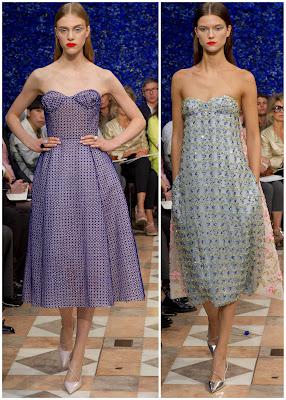
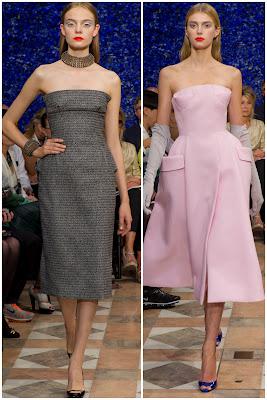
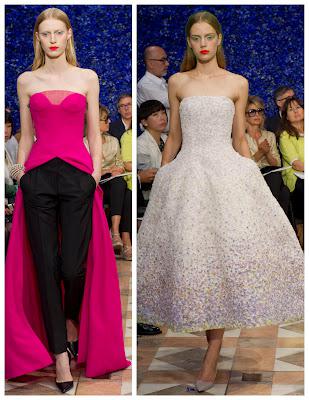 While most expected a bang, I think that Raf has begun his career at Dior with a whisper. But a strong, powerful whisper is better than all flash and no substance. This is a step in the right direction and I hope that Bernard Arnault and the rest of LVMH give Simons the time and creative freedom to grow into a true couturier.
While most expected a bang, I think that Raf has begun his career at Dior with a whisper. But a strong, powerful whisper is better than all flash and no substance. This is a step in the right direction and I hope that Bernard Arnault and the rest of LVMH give Simons the time and creative freedom to grow into a true couturier.
(All pictures courtesy of Vogue UK and edited by The Bostonista)


COMMENTS ( 1 )
posted on 10 July at 14:13
I have becomed obsessed with looking for negative reviews and/or comments on Raf Simons' first couture collection for Dior. And I find it a real problem that I've found maybe… one. It would appear that a lot of hope and dreams have been assigned to Mr. Simons as to how to (re)interpret the House of Dior. But it seems that the persons who control fashion commentary have lost their perspective, their references and something else which I've already forgotten. Christian Dior was an innovator: aside from his famous New Look silhouette of 1947 (which was considered "shocking" because, after wartime rationing and the lack of anything, the vast amounts of fabric it took just to construct the skirt actually induced public demonstrations), he also created the fashionably vertical "A" and "H" lines of the 1950s, which completely modernized and changed women's fashion forever — although Claire McCardell can also be credited for this. M Dior understood how to recreate and manipulate the living body under the dress — with sculptured corseting — so that the sensual lines of a silhouette were properly pushed and pulled in the right places, maximizing each and every one of the client's best assets. As this tradition no longer exists, I suppose one can't fault R Simons' take on what Dior had represented (at least until after Saint Laurent's term); the tiny bra cups (grant it, there was very little breast meat on those chickens to hold anything up) and the over-emphasized hips (which Christian Dior had introduced in his day with "meaning" and "proportional logic") seemed either wrong, unfinished or merely arbitrary, as if trying to say, "It's Dior" rather than "this is exceptional fashion worth the very high price you are going to have to pay to wear it". In my mind, this collection could have been a H&M/Dior collaboration for 2014… and who knows? I guess all the mag editors are just trying to up the ante with their LVMH ad pages, I'm not buying it. I do wish Raf Simons all the luck in the world (mark my words, he is going to need it, in this "Maison" anyway). And I never thought I would see the day when I might actually miss John Galliano. There, I said it, I can cancel my therapy sessions for this week.